
Cologne is the largest city of the German western state of North Rhine-Westphalia (NRW) and the fourth-most populous city of Germany with 1.1 million inhabitants in the city proper and 3.6 million people in the urban region. Centered on the left (west) bank of the Rhine, Cologne is about 35 km (22 mi) southeast of NRW's state capital Düsseldorf and 25 km (16 mi) northwest of Bonn, the former capital of West Germany.

The architecture of cathedrals and great churches is characterised by the buildings' large scale and follows one of several branching traditions of form, function and style that derive ultimately from the Early Christian architectural traditions established in Late Antiquity during the Christianisation of the Roman Empire.
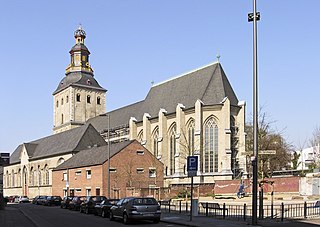
The Basilica church of St. Ursula is located in Cologne, North Rhine-Westphalia, Germany. It is built upon the ancient ruins of a Roman cemetery, where the 11,000 virgins associated with the legend of Saint Ursula are said to have been buried. The church has an impressive reliquary created from the bones of the former occupants of the cemetery. It is one of the twelve Romanesque churches of Cologne and was designated a Minor Basilica on 25 June 1920. While the nave and main tower are Romanesque, the choir has been rebuilt in the Gothic style.
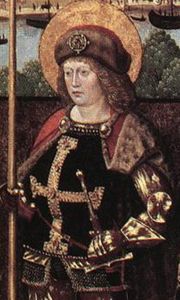
Saint Gereon of Cologne, who may have been a soldier, was martyred at Cologne by beheading, probably in the early 4th century.

The Great Saint Martin Church is a Romanesque Catholic church in Cologne, Germany. Its foundations rest on remnants of a Roman chapel, built on what was then an island in the Rhine. The church was later transformed into a Benedictine monastery. The current buildings, including a soaring crossing tower that is a landmark of Cologne's Old Town, were erected between 1150-1250. The architecture of its eastern end forms a triconch or trefoil plan, consisting of three apses around the crossing, similar to that at St. Maria im Kapitol. The church was badly damaged in World War II; restoration work was completed in 1985.

Bonn Minster is a Roman Catholic church in Bonn. It is one of Germany's oldest churches, having been built between the 11th and 13th centuries. At one point the church served as the de facto cathedral for the Archbishopric of Cologne, because it is the major church of what was then the Archbishop-Elector's residence. It is now a minor basilica. It served as the inspiration for the Kaiser Wilhelm Memorial Church in Berlin, as Kaiser Wilhelm II had studied in Bonn.

The Basilica of Saint Servatius is a Roman Catholic church dedicated to Saint Servatius, in the city of Maastricht, the Netherlands. The architecturally hybrid but mainly Romanesque church is situated next to the Gothic church of Saint John, backing onto the town's main square, Vrijthof.
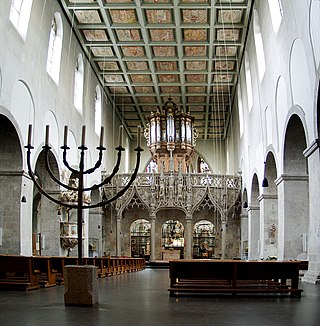
The Church of Saint Pantaleon is an early Romanesque church in Cologne, Germany. The church dates back to the 10th century and is one of the twelve Romanesque churches of Cologne. The former monastery church is consecrated to Saint Pantaleon and the Saints Cosmas and Damian and is the oldest church of the cult of Saint Pantaleon west of Byzantium. The empress Theophanu and the archbishop Bruno the Great are buried in the church, which also contains shrines of saints Alban, the first Christian martyr of Britain, and Maurinus of Cologne. Pope Benedict XVI visited the church in 2005.

Innenstadt is the central borough (Stadtbezirk) of the City of Cologne in Germany.
The twelve Romanesque churches of Cologne are twelve landmark churches in the Old town (Altstadt) of Cologne, Germany. All twelve churches are Catholic.

St. Maria im Kapitol is an 11th-century Romanesque church located in the Kapitol-Viertel in the old town of Cologne, Germany. The name “im Kapitol“ refers to the Roman temple for the Capitoline Triad that was built on today’s site of the church in the first century. The Catholic church is based on the Church of the Nativity in Bethlehem, was dedicated to St. Mary and built between 1040 and 1065. It is one of twelve Romanesque churches built in Cologne during this period.
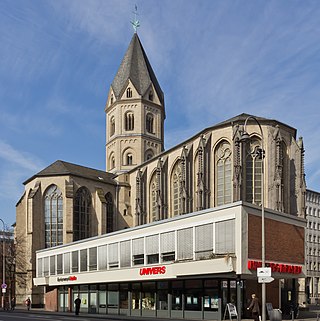
St. Andrew's is a 10th-century Romanesque church located in the old town of Cologne, Germany. It is one of twelve churches built in Cologne in that period. Archbishop Gero consecrated the church in 974, dedicating it to St. Andrew, although an earlier church at the site was dedicated to St. Matthew. In the 12th century, the church was rebuilt in the Romanesque style, and was probably completed after the great fire of Cologne in 1220. In the crypt of the church lies a Roman sarcophagus from the 3rd century, which holds the remains of the 13th-century theologian and natural philosopher St. Albertus Magnus. Since 1947, the Dominican Order has ministered to the church.

The Basilica of St. Severin is an early Romanesque basilica church located in the Südstadt of Cologne (Köln). The former collegiate church is dedicated to St. Severin of Cologne. It is one of the twelve Romanesque churches of Cologne.
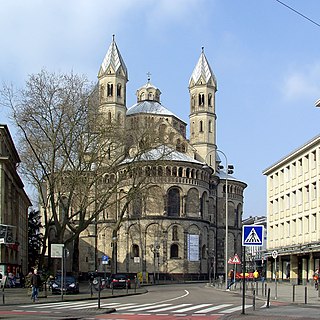
The Basilica of the Holy Apostles is a Romanesque church in Cologne (Köln), located near Innenstadt's busy Neumarkt (Köln). The former collegiate church is dedicated to the twelve Apostles. It is one of the twelve Romanesque churches built in Cologne in that period.

St. Cecilia's Church is one of the twelve Romanesque churches in Cologne’s old city, maintained by the Foundation of Romanesque Churches in Cologne. The present building, little changed since its inception, dates from 1130-60. Since 1956, the church has been the home of the Schnütgen Museum for medieval art.

The Basilica of St. Cunibert also St. Kunibert is the last of Cologne's twelve Romanesque churches to be built. It was consecrated 1247, one year before work on the Gothic Cologne Cathedral began. It was declared a minor basilica in 1998 by the then Pope John Paul II.
The following is a timeline of the history of the city of Cologne, Germany.

St. Georg's Church is one of twelve Romanesque churches in the city of Cologne, Germany.

St. Maria Lyskirchen is one of twelve Romanesque churches in Cologne, Germany.


















